Search results for: 'Rom'
-
 Late Roman glass bottle
Late Roman glass bottleFrei geblasenes Glasfläschchen aus dem 3. bis 5. Jh. n. Chr., Spätantike.
Price: on request Ancient clay bottle
Ancient clay bottleElegant geformtes, kleines Fläschchen aus cremefarbenem Ton. Vermutlich für kostbare Flüssigkeiten verwendet. Henkelansatz noch erkennbar. Originale Fundanhaftungen.
Price: on request Gruppe antiker Gewichte aus dem heiligen Land
Gruppe antiker Gewichte aus dem heiligen LandInsgesamt 21 Exemplare. Hervorragender Zustand. Durchmesser 6 mm - 17 mm. Einzelgewicht von 0.29 g bis 9.02 g. Zusammen 67.65 Gramm.
Price: on request Zwei antike Spinnwirtel
Zwei antike SpinnwirtelGruppe antiker bis spätantiker Spinnwirtel aus Bein oder Holz. Interessanter Typ. Auch Verwendung als Perlenschmuck denkbar.
Price: on request Sehr seltener Denar des Vespasian - RIC R2
Sehr seltener Denar des Vespasian - RIC R2AV: IMP CAESAR VESPASIANVS AVG; RV: LIBERTAS - PVBLICA. 2,9 Gramm, Zustand: ss - vz
Price: on request Workpiece of a Roman intaglio
Workpiece of a Roman intaglioThis ancient intaglio from Roman times shows a standing figure. The glass paste has a beautiful blue colour.
Price: on request Two Roman potsherds from the Rhineland
Two Roman potsherds from the RhinelandFragments of Roman pottery. Finds from the Roman city of Novaesium, today's Neuss in Germany.
Price: on request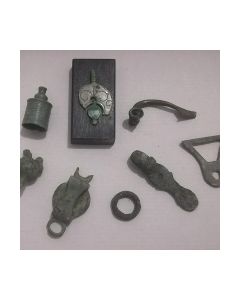 Eight Roman bronze artefacts
Eight Roman bronze artefactsVarious artefacts in different states of preservation. Finds from the Roman city of Novaesium, today's Neuss in Germany.
Price: on request Four Roman iron artefacts
Four Roman iron artefactsArrow heads, chisel and blade made of Iron. Finds from the Roman city of Novaesium, today's Neuss in Germany.
Price: on request Eight Roman bronze artifacts
Eight Roman bronze artifactsVarious artifacts in different states of preservation. Finds from the Roman city of Novaesium, today's Neuss in Germany.
Price: on request Roman gaming pieces from the Rhineland
Roman gaming pieces from the Rhineland6 Roman glass gaming pieces and 8 other Roman artefacts. Finds from the Roman city of Novaesium, today's Neuss in Germany.
Price: on request Three Roman lead weights from the Rhineland
Three Roman lead weights from the RhinelandDifferent types of weights made of lead. Finds from the Roman city of Novaesium, today's Neuss in Germany.
Price: on request Roman potsherds from the Rhineland
Roman potsherds from the RhinelandFragments of Roman vessels and bricks, and of two amphora handles. Finds from the Roman city of Novaesium, today's Neuss in Germany.
Price: on request Roman glass fragments from the Rhineland
Roman glass fragments from the RhinelandFragments of glass vessels and rods, as well as two faience beads. Finds from the Roman city of Novaesium, today's Neuss in Germany.
Price: on request Roman artefacts from the Rhineland
Roman artefacts from the RhinelandFragments of Roman pottery vessels, bronze and glass fragment, as well as a piece of a mosaic. Finds from the Roman city of Novaesium, today's Neuss in Germany.
Price: on request Rare Roman mosaic glass face bead showing Medusa head
Rare Roman mosaic glass face bead showing Medusa headMosaikglasperle aus einer oströmischen Werkstatt des 1. Jh. n. Chr., möglicherweise ägyptisch oder nubischer Import. Das abgebildete Frauengesicht wird gerne als Darstellung der Medusa gedeutet.
Price: on request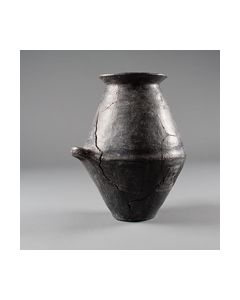 Funerary urn from the Villanova culture - found in Chiusi, Italy
Funerary urn from the Villanova culture - found in Chiusi, ItalyKeramik aus dem 9. Jh. v. Chr., unmittelbar vor der etruskischen Besiedelung. Ritzdekor aus Swastika und anderen geometrischen Elementen. Gefunden in Chiusi, Norditalien.
Price: on request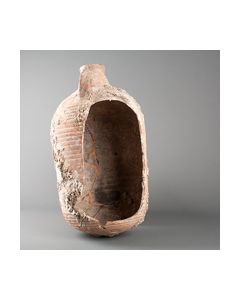 Small wash-bowl amphora from an old German collection - found in the mediterranean
Small wash-bowl amphora from an old German collection - found in the mediterraneanKleine ovoide Amphore. Gedrungener Körper mit runder Schulter und rundem Bodenstück. Tauchfund aus dem Mittelmeer, mit maritimen Verkrustungen.
Price: on request Extremely rare large Roman pottery lantern
Extremely rare large Roman pottery lanternSuch lanterns are extremely rare, even in large museum collections and catalogues.
Price: on request Ancient lead shell-shaped weight from Israel - 98.7 g.
Ancient lead shell-shaped weight from Israel - 98.7 g.98,7g, 13 phönizische Schekel. Fund aus Israel. Aus Blei gegossen, unter Verwendung einer Herzmuschel als Form. Seltenes Belegstück für muschelförmige Gewichte aus dem 4. bis 2. Jh. v. Chr.
Price: on request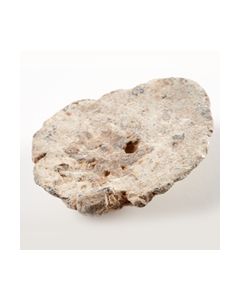 Ancient lead shell-shaped weight from Israel - 39.6g
Ancient lead shell-shaped weight from Israel - 39.6g39,6g, knapp 6 phönizische Schekel. Fund aus Israel. Aus Blei gegossen, unter Verwendung einer Herzmuschel als Form. Seltenes Belegstück für muschelförmige Gewichte aus dem 4. bis 2. Jh. v. Chr.
Price: on request Massive lead weight from Samaria in the Holy Land - 65.1g
Massive lead weight from Samaria in the Holy Land - 65.1gMassives Bleigewicht aus dem heiligen Land. Quadratische Platte mit konkaven Seiten, ähnlich antiken Rohmetallbarren. 65,1g schwer, entsprechend 1/5 Libra.
Price: on request Published Egyptian mummy cartonnage from Gizeh
Published Egyptian mummy cartonnage from GizehBegutachtet und wissenschaftlich bearbeitet durch Prof. Dr. Dieter Kurth vom Archäologischen Institut der Universität Hamburg. Stuckiertes Leinen mit vollständiger hieroglyphischer Formel. Original erhaltene Farben.
Price: on request Polychromic sarcophagus mask from Ancient Egypt
Polychromic sarcophagus mask from Ancient EgyptBemalte Holzmaske aus ptolemäischer Zeit. Kunstvoller Sarkophagschmuck in museumswürdiger Erhaltung. Ca. 18cm lang, 11cm breit.
Price: on request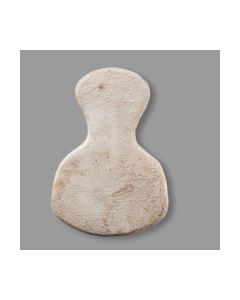 Kusura-type idol from 3rd millenium BC Anatolia examined by Prof. Lambert
Kusura-type idol from 3rd millenium BC Anatolia examined by Prof. LambertIdol vom sogenannten Kusura-Typus, aus weißem, feinkristallinem Marmor. Bronzezeit Anatoliens, 3. Jt. v. Chr. Begutachtet durch Professor W. G. Lambert. Museumswürdig.
Price: on request Cylindrin Nayarit pottery from western Mexiko
Cylindrin Nayarit pottery from western MexikoSeltene mittelamerikanische Keramik aus dem westlichen Mexiko. Mit Glasur und Strichdekor. 200 v. Chr. bis 100 n. Chr.
Price: on request Thin butted axe head from the Funnel Beaker culture
Thin butted axe head from the Funnel Beaker cultureDünnnackige Beilklinge aus grauem Flint mit schönen rot-braunen Einschlüssen. Dolmenzeit bis Ganggrabzeit. Beeindruckend durch die Größe.
Price: on request Neolithic axe head from the Corded Ware culture
Neolithic axe head from the Corded Ware cultureDicknackiger Beilkopf aus Feuerstein. Variante des Kregme-Typs. Einzelgrabkultur oder evt. Anfang der Dolchzeit, 2800 v. Chr. bis 1800 v. Chr.
Price: on request Michelsberger culture artefacts from museum stock - found in Camp-a-Cayaux, Belgium
Michelsberger culture artefacts from museum stock - found in Camp-a-Cayaux, BelgiumFunde vom Camp-a-Cayaux, bei neolithischer Flintmine in Spiennes, Belgien. Abschläge und Werkzeuge. 4500 v. Chr. bis 3500 v. Chr.
Price: on request Roman glass
Roman glassRoman glass from the 1th to 4th century AD. Small flask in fine condition.
Price: on request 101 Roman bronze coins
101 Roman bronze coinsVon Augustus über die Soldatenkaiser bis zur Spätantike. Diverse Nominale, Durchmesser ca. 13 mm - 27 mm.
Price: on request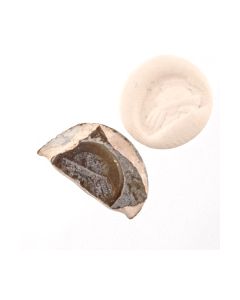 Roman intaglio with portrait head
Roman intaglio with portrait headDark glass paste with portrait head of a young woman. She is wearing a traditional headband. The hair is worn in locks falling in her neck. Dating from Roman Republic to Roman Imperial times. From the Professor Brosch collection of ancient engraved gems.
Price: on request Double spiral pendant from Bronze Age Central Europe
Double spiral pendant from Bronze Age Central EuropeTypical decorative element of a wealthy woman's dress in the European Middle Bronze Age. Several of these spiral pendants were worn around the waist. Similar to belt mounts or charms. 1500 to 1200 BC.
Price: on request Whistle from plastic bronze
Whistle from plastic bronzeNice small whistle made of a high lead content bronze. Probably produced in the Modern Age.
Price: on request Rare Roman bronze askos
Rare Roman bronze askosSmall massive duck-shaped jug with lovely decorated handle showing an animal mask.
Price: on request Pin from Luristan
Pin from LuristanIron Age bronze pin with thick head. Green patinated metal.
Price: on request

